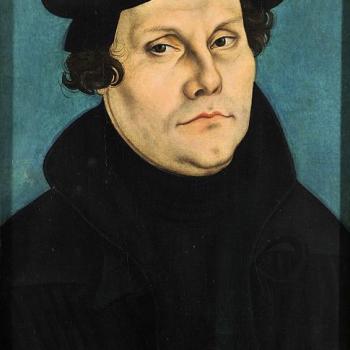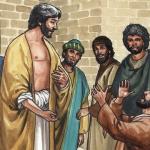* *
Nathan Rinne (words in blue in this paper) is a friendly and able Lutheran apologist, with whom I have been having cordial discussions. He first showed up on my blog with a comment under a post of mine about Luther. Nathan then started expressing interest in replying to my (five) critiques of Martin Chemnitz.
His reply is entitled, My reply to RC apologist Dave Armstrong, regarding his examination of Martin Chemnitz’s Examination. In the Introduction, he stated that I “will be answering it line-by-line on his blog.” That was predicated upon his being willing to critique my papers line-by-line. But he has only selectively replied:
*
Therefore, I trust that I may be excused if I don’t reply to absolutely every jot and tittle. I will still likely respond to virtually all of his paper, though, because that is my usual method. I don’t think that his reply is truly a response to these five papers (technically speaking). It is a more wide-ranging and general critique of Catholic distinctives, and defense of the Lutheran worldview. My title reflects this.
I appreciate Nathan’s kind words at the beginning of his reply. I, too, have enjoyed our interactions a lot, and have respect for his work and his demeanor. It’s a true pleasure to take part in a non-acrimonious dialogue, in good faith, with two parties confident and secure in their positions (which generally means there is no need for desperate, evasive personal attacks; charges of lying, etc.). Such a phenomenon seems to be as rare as a square circle anymore online.
*
We Catholics agree, since for us, apostolic tradition and Scripture must always be in harmony. The former can never contradict the latter. Note how St. Jerome specifically mentions “apostolic” tradition, over against false traditions of men (“of their own accord . . . invent and think up”). All he’s saying here is that non-apostolic traditions contradict Scripture. He is not denying that apostolic tradition is also authoritative and a norm of faith. Thus it is no evidence whatsoever of a sola Scriptura position (as Chemnitz probably intended it to be).
The same St. Jerome also wrote:
I will tell you my opinion briefly and without reserve. We ought to remain in that Church which was founded by the Apostles and continues to this day. If ever you hear of any that are called Christians taking their name not from the Lord Jesus Christ, but from some other, for instance, Marcionites, Valentinians, Men of the mountain or the plain, you may be sure that you have there not the Church of Christ, but the synagogue of Antichrist. For the fact that they took their rise after the foundation of the Church is proof that they are those whose coming the Apostle foretold. And let them not flatter themselves if they think they have Scripture authority for their assertions, since the devil himself quoted Scripture, and the essence of the Scriptures is not the letter, but the meaning. Otherwise, if we follow the letter, we too can concoct a new dogma and assert that such persons as wear shoes and have two coats must not be received into the Church.
*
Of course they are in agreement with the Bible. That is the Catholic position of the three-legged stool: Bible-Tradition-Church: all harmonious: all of a piece. Few fathers talked more about the sublime authority of apostolic succession and apostolic tradition than St. Irenaeus. He was no advocate of sola Scriptura. I maintain that it is special pleading to contend that any major Church father was such. I’ve never seen any evidence of it. For much more on St. Irenaeus’ view of authority and the rule of faith, see two papers from an Orthodox writer, Robert Arakaki:
Irenaeus of Lyons: Contending for the Faith Once Delivered
Response to Robin Phillips “Questions About St. Irenaeus and Apostolic Succession”
Many patristic passages where Scripture is extolled are falsely interpreted as proclaiming sola Scriptura (whole books have been put together on these lines), but it is not the case. To have a high view of Scripture is not the equivalent of making the Bible the sole infallible rule of faith.
*
Amen! This expresses the material sufficiency of Scripture, that I and most Catholics hold. We deny, on the other hand, the formal sufficiency of Scripture, which is sola Scriptura as the rule of faith. This was a 16th-century novel innovation that cannot be traced back to the fathers or apostles or the Bible itself.
*
Then it shall be very easy going!!! Just teasing . . .
*
Likewise. I look at dialogue as an opportunity for both parties to learn and grow, and follow truth wherever it leads. To me, that is the excitement and utility of it. It’s not a means to belittle and put down the other person,with a goal to “win at all costs” (including the cost of forsaking truth). So we are on the same page in this respect. I believe that truth has an inherent power, and that those who sincerely seek it will indeed find it, by the enabling of God’s grace.
*
Amen again! And this immediately brings us to a discussion of what corporate interpretation means. Lutherans go back to the authority of their confessions in the Book of Concord. But I say that they, in turn, have to be in line with apostolic (and Catholic) tradition, going all the way back, and that in fact they are not in accord with that, where they differ from Catholic teachings and doctrines. Lutherans have enough respect for the fathers to be concerned that their teachings are supported by them. I have not found this alleged patristic support to be the case, however, in my many debates with Lutherans about patristic views.
The concept of a contemporaneous existence of the Word of God in a corrupted verbal form, and a pure written form, spawned Chemnitz’s explanation of traditiones in the second locus, De traditionibus. Here he lists the first of eight different types of traditiones as Scripture itself, i.e. the things that Christ and the Apostles preached orally and were later written down. Then follows: 2) the faithful transmission of the Scriptures; 3) the oral tradition of the Apostles (which by its very nature must agree with the contents of the New Testament canon); 4) the proper interpretation of the Scriptures received from the Apostles and “Apostolic men”; 5) dogmas that are not set forth in so many words in Scripture but are clearly apparent from a sampling of texts; 6) the consensus of true and pure antiquity; 7) rites and customs that are edifying and believed to be Apostolic, but cannot be proved from Scripture. Chemnitz rejects only the eighth kind of tradition: [8] traditions pertaining to faith and morals that cannot be proved with any testimony of Scripture; but which the Council of Trent commanded to be accepted and venerated with the same reverence and devotion as the Scripture. The important element of this last of the traditiones appears not to be the fact that such traditions of faith and morals not provable from Scripture actually existed, but that their status of equality with Scripture was foisted upon the church by the Council of Trent.” P. Strawn, Cyril of Alexandria as a Source for Martin Chemnitz, in Die Patristik in der Bibelexegese des 16. Jahrhunderts, Wolfenbu”ttleler Forschungen, Bd. 85, Hrsg. v. David C. Steinmetz, Wiesbaden 1999, p. 213-14.
*
This hinges on what is meant by “proved” from Scripture, and the criterion of “clearly demonstrable.” Those things are subjective, and reasonable men can disagree. The nature and scope of “proof” cannot simply be some tradition of men, itself unattached to biblical criteria. It seems to me that it has to be in harmony with biblical thought. Likewise, clarity or perspicuity is often arguable, concerning particular doctrines and how “proved” they are. I’ve written two books critiquing sola Scriptura (the latest one to be published by Catholic Answers next year). I haven’t seen any biblical proof at all of that doctrine. And I have seen much scriptural disproof of it and also an important component of it: perspicuity of Scripture. As I argued in my “Reply to Dr. Gene Veith on Catholic Mariology”:
We contend that all Catholic doctrines (including even the dreaded Marian ones) are present in Scripture, explicitly, implicitly, or clearly able to be deduced from either sort of evidence (material sufficiency).
There are different levels of such evidence. The Virgin Birth has but a few support passages. Original sin also has only a few. Yet both are firmly believed by Christians of all stripes. Original sin isn’t even mentioned in the Nicene Creed, and Cardinal Newman noted that there was far more support for purgatory in the fathers than for original sin.
Other things have to be (mostly or largely) deduced. Under this category would come things like the Two Natures of Christ. It’s in Scripture, assuredly, but has to be “teased” out of it by an examination of many passages together. Even the Holy Trinity is mostly of that nature. I have papers giving many hundreds of biblical proofs for the Trinity, but they are not always evident at first glance. As a result, Christology developed in the early Church for about 600 years: . . .
Other things are totally absent in Scripture, yet believed by Protestants, who claim to be “Scripture Alone” (as infallible authority). The canon of the Bible is the best and most undeniable example of that. Protestants are forced to accept a “fallible list of infallible books” — as R. C. Sproul has candidly admitted. And they have to rely on the (Catholic) Church authority that proclaimed the canon (minus the deuterocanon). Sola Scriptura is another. It’s found nowhere in Scripture.
. . . Nowhere does it say in Holy Scripture that the Bible only is the infallible guide and rule of faith, to the exclusion of an infallible Church or infallible apostolic tradition (which is precisely what the Protestant contention is). And the Bible contradicts it all over the place. But that doesn’t stop Protestants from believing it and basing their entire system of authority and method of theology on it: castles made of sand, like the old Jimi Hendrix song . . .
Denominations are nowhere found in the New Testament, which everywhere refers to one Church with one solid set of beliefs, that are non-negotiable. This is beyond all dispute. Many Protestant thinkers readily concede this, and lament it. Yet all Protestants live with the tension of the very existence of denominations being dead-set against what the Bible teaches about ecclesiastical authority and belief-systems of theological truth. . . .
Now, all that was my roundabout way of addressing the criticism that our Marian doctrines are supposedly not “in” the Bible. They certainly are: just not (usually) explicitly, or sometimes (as in the Assumption) not implicitly, either, and able only to be deduced from other things. But this shouldn’t pose any problem for the Protestant (unless we adopt double standards) because, as I’ve shown, they believe many things that are only infrequently indicated in the Bible or not at all. Neither the canon issue nor the denominational scandal ever seem to cause any Protestants to reject their own system.
So that is one reply: we reject the double standard whereby you guys believe all that (and other things, too) with small or no biblical support, while at the same time demanding hyper-biblical-support for every one of our doctrines, as if we don’t have it and you do for absolutely everything you believe and even make a “pillar” of your system.
The second answer is that explicit support is not required anyway, because the Bible never teaches that: that every doctrine must be explicitly indicated in the Bible and nowhere else. If we are fully “biblical” that notion is completely absent. So why follow it? Well, because it is an entrenched, arbitrary tradition of man, is what it amounts to. [last italics added presently]
I add now, that this notion Chemnitz has, that a doctrine more explicitly indicated in Scripture is automatically superior to one that is less explicitly or only implicitly indicated (or, as he would say, absent altogether, when often this is debatable), is itself a concept that Scripture (to my knowledge) never asserts. So where does it come from? Well, it is a deduction of a notion that is itself not able to be proved from Scripture: sola Scriptura. Chemnitz is thus relying heavily on an arbitrary, unbiblical notion of men that is based on another presupposition that is an arbitrary, unbiblical notion of men. If anyone doubts this, then I would challenge him to find where in Chemnitz he explains and defends the rationale or basis for this notion; on what basis does he hold it in the first place? Where is his biblical proof?
What Catholics would regard as perfectly harmonious with Scripture; therefore, “biblical”; Chemnitz would reject as “unbiblical.” It comes down to a matter of definition and criteria for levels of “proof” or demonstration. In the end, each doctrine will have to be gone through individually, to establish if it is sufficiently “biblical.” That is my apologetic specialty, so I’d be glad — more than happy — to do that. Every time I’ve set out to find biblical indication of a Catholic doctrine, I’ve found it. Relative strength or weakness may be debated, but I found something every time.
I will continue returning to this theme throughout my paper, because I think this is the central point.
*
Then I will expect you to give individual examples of doctrines supposedly entirely missing from the Bible, and then you’ll have to interact with my arguments that they are present. It’s not enough to merely make the assertion. Now you will have to demonstrate it and interact with rebuttals. Protestants make the bald claims all the time, but when asked or challenged to defend their assertions, oftentimes it is a far different story, with much less confidence exhibited, for some reason.
In a nutshell, here is my contention: The best and most faithful of the Apostolic Fathers (i.e. the most Apostolic among them) believed that all essential doctrines – for all practical purposes, the Rule of Faith – could be proven with Scripture, even if they did hold to other (non-binding) teachings as well.
*
Again, it all comes down to what you mean by “proven with Scripture,” and how you arrive at this determination; then it is a matter of examining relevant patristic passages. You may assume this means sola Scriptura, which we reject, while I would argue that it is material sufficiency, which we accept.
For example, Irenaeus essentially says that the Rule of Faith is “in agreement with the Scriptures”.
*
He does not! To say that true doctrine agrees with Scripture does not contradict the Catholic position at all. This is what he believed (see my three links above). He doesn’t make sola Scriptura (Scripture as the only infallible norm and standard of faith or belief) the rule of faith: that is a whole ‘nother ball of wax. This is a factual matter, and it is easy to prove that St. Irenaeus held a thoroughly Catholic view, not proto-Lutheran or any kind of proto-Protestant view. I’ve already provided several proofs of that, and I have more in my third critique of Chemnitz and also some twenty pages in my book, Catholic Church Fathers (I will send you a free e-book copy via e-mail).
We must take very seriously these own men’s words about the primacy and centrality of Scripture for those legitimately ordained men holding to the true Rule of Faith. Forgiveness, life, and salvation are at stake.
*
Yes, we must — rightly interpreted. We can’t simply anachronistically read in our views. I shall cite two prominent Lutherans with regard to this general point:
As regards the pre-Augustinian Church, there is in our time a striking convergence of scholarly opinion that Scripture and Tradition are for the early Church in no sense mutually exclusive: kerygma, Scripture and Tradition coincide entirely. The Church preaches the kerygma which is to be found in toto in written form in the canonical books.The Tradition is not understood as an addition to the kerygma contained in Scripture but as the handing down of that same kerygma in living form: in other words everything is to be found in Scripture and at the same time everything is in the living Tradition. It is in the living, visible Body of Christ, inspired and vivified by the operation of the Holy Spirit, that Scripture and Tradition coinhere . . . Both Scripture and Tradition issue from the same source: the Word of God, Revelation . . . Only within the Church can this kerygma be handed down undefiled . . .
(Heiko Oberman, The Harvest of Medieval Theology, Grand Rapids, Michigan: Eerdmans, revised 1967, 366-367)
Clearly it is an anachronism to superimpose upon the discussions of the second and third centuries categories derived from the controversies over the relation of Scripture and tradition in the 16th century, for ‘in the ante-Nicene Church . . . there was no notion of sola Scriptura, but neither was there a doctrine of traditio sola.’. . . (1)The apostolic tradition was a public tradition . . . So palpable was this apostolic tradition that even if the apostles had not left behind the Scriptures to serve as normative evidence of their doctrine, the church would still be in a position to follow ‘the structure of the tradition which they handed on to those to whom they committed the churches (2).’ This was, in fact, what the church was doing in those barbarian territories where believers did not have access to the written deposit, but still carefully guarded the ancient tradition of the apostles, summarized in the creed . . . The term ‘rule of faith’ or ‘rule of truth’ . . . seems sometimes to have meant the ‘tradition,’ sometimes the Scriptures, sometimes the message of the gospel . . . In the . . . Reformation . . . the supporters of the sole authority of Scripture . . . overlooked the function of tradition in securing what they regarded as the correct exegesis of Scripture against heretical alternatives.
(Jaroslav Pelikan, The Christian Tradition: A History of the Development of Doctrine: Vol.1 of 5: The Emergence of the Catholic Tradition (100-600), Chicago: Univ. of Chicago Press, 1971, pp. 115-17, 119; citations: 1. In Cushman, Robert E. and Egil Grislis, editors, The Heritage of Christian Thought: Essays in Honor of Robert Lowry Calhoun, New York: 1965, quote from Albert Outler, “The Sense of Tradition in the Ante-Nicene Church,” p. 29. 2. St. Irenaeus, Against Heresies, 3:4:1)
Likewise, Anglican church historian J. N. D. Kelly:
It should be unnecessary to accumulate further evidence.Throughout the whole period Scripture and tradition ranked as complementary authorities, media different in form but coincident in content. To inquire which counted as superior or more ultimate is to pose the question in misleading terms. If Scripture was abundantly sufficient in principle, tradition was recognized as the surest clue to its interpretation, for in tradition the Church retained, as a legacy from the apostles which was embedded in all the organs of her institutional life, an unerring grasp of the real purport and meaning of the revelation to which Scripture and tradition alike bore witness.
(Early Christian Doctrines, San Francisco: Harper and Row, 1978, 47-48)
In other words, if these men had been challenged by heresies that took teachings they had never questioned as being non-essential too far (in a way that endangered the proper teaching of Christ, grace, and faith), they would have gone back to the Scriptures, and begin the process of righting their wrongs.
*
Indeed, they did do so. They went to Scripture first, and made the appropriate arguments. If the heretic was still obstinate, their trump card was to appeal to the authority of the unbroken apostolic tradition of the Church.
The fullness of the Rule of Faith is often only known tacitly (and will, of course, be confirmable in Scripture – when one finally looks with the right questions and problems in mind: “[the Rule of Faith’s] contents coincided with those of the Bible [for Origin]” [-J.N.D. Kelley]).
*
It takes the circumstances of history to “draw out” further explicit content, that is, essential doctrine, starting with the ecumenical creeds and including also the doctrine of justification. We have begun to really understand, even as we long to understand more (for example, objectively speaking, passages like Isaiah 53 really are clearly about Jesus Christ, even if that knowledge has not become clear or fully dawned in the faithful).
*
Development of doctrine is necessary and inevitable for all doctrines. It’s my favorite theological topic, and was the largest persuasive factor in my conversion to Catholicism.
As regards this drawing out of essential doctrine, the matter of interpretation is involved (note also: “[for Origin, the Rule of Faith] was formally independent of the Bible, and also included the principles of Biblical interpretation ” [-J.N.D. Kelley]). Here you will recall what I said earlier about how the Berean’s treatment of the Scriptures in Acts 17 plays out on the ground: a) their gut impulse is to go to those formal Scriptures held to by believers and test…. and b) things they may not have seen before they clearly are able to locate after Paul has preached and taught.
*
Interpretation had to be within the matrix of the Church’s orthodox theology.
Lactanius said: “For the contest [over who is the true Catholic Church] is respecting life and salvation, which, unless it is carefully and diligently kept in view, will be lost and extinguished.” (as you quoted him) So again, where is the Church? I like how Douglas Johnson puts it: “Salvation by grace through faith in Jesus Christ is at the heart of all the great controversies that shook the Early church as it tried to work out its own self-understanding”. Indeed, and in the Reformation, we simply see the continuing of this process.
*
Salvation by grace alone (over against Pelagianism) is biblical, apostolic, and patristic teaching, not salvation by faith alone (a Protestant novelty).


















